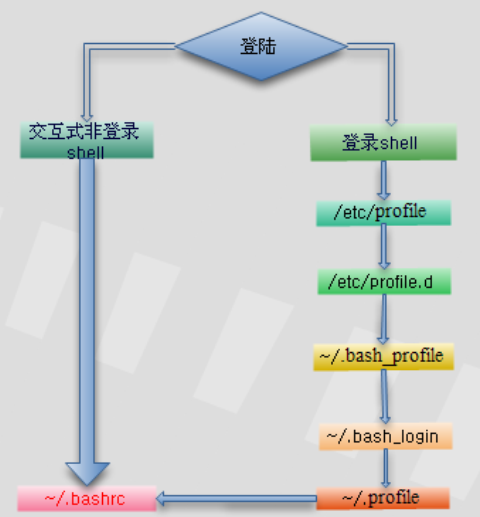/etc/profile、~/.bash_profile等幾個檔案的執行過程


關於登入linux時,/etc/profile、~/.bash_profile等幾個檔案的執行過程。
在登入Linux時要執行檔案的過程如下:
在 剛登入Linux時,首先啟動 /etc/profile 檔案,然後再啟動使用者目錄下的 ~/.bash_profile、 ~/.bash_login或 ~/.profile檔案中的其中一個,執行的順序為:~/.bash_profile、 ~/.bash_login、 ~/.profile。如果 ~/.bash_profile檔案存在的話,一般還會執行 ~/.bashrc檔案。因為在 ~/.bash_profile檔案中一般會有下面的程式碼:
if [ -f ~/.bashrc ] ; then
. ./bashrc
fi
~/.bashrc中,一般還會有以下程式碼:
if [ -f /etc/bashrc ] ; then
. /etc/bashrc
fi
所以,~/.bashrc會呼叫 /etc/bashrc檔案。最後,在退出shell時,還會執行 ~/.bash_logout檔案。
執 行順序為:/etc/profile -> (~/.bash_profile | ~/.bash_login | ~/.profile) -> ~/.bashrc ->/etc/bashrc -> ~/.bash_logout
關於各個檔案的作用域,在網上找到了以下說明:
(1)/etc/profile: 此檔案為系統的每個使用者設定環境資訊,當使用者第一次登入時,該檔案被執行. 並從/etc/profile.d目錄的配置檔案中搜集shell的設定。
(2)/etc/bashrc: 為每一個執行bash shell的使用者執行此檔案.當bash shell被開啟時,該檔案被讀取。
(3)~/.bash_profile: 每個使用者都可使用該檔案輸入專用於自己使用的shell資訊,當使用者登入時,該檔案僅僅執行一次!預設情況下,他設定一些環境變數,執行使用者的.bashrc檔案。
(4)~/.bashrc: 該檔案包含專用於你的bash shell的bash資訊,當登入時以及每次開啟新的shell時,該該檔案被讀取。
(5)~/.bash_logout: 當每次退出系統(退出bash shell)時,執行該檔案. 另外,/etc/profile中設定的變數(全域性)的可以作用於任何使用者,而~/.bashrc等中設定的變數(區域性)只能繼承/etc /profile中的變數,他們是"父子"關係。
(6)~/.bash_profile 是互動式、login 方式進入 bash 執行的~/.bashrc 是互動式 non-login 方式進入 bash 執行的通常二者設定大致相同,所以通常前者會呼叫後者。
我 做了個實驗,在/etc/profile,/etc/bashrc,~/.bashrc和~/.bash_profile檔案的最後追加同一個變數分別賦 予不同的值,實驗結果表明變數最後的值為~/.bash_profile裡的值。(4個檔案都沒有修改其他設定,都是安裝系統後的預設值。)
再有就是4個檔案都追加一個值到同一個檔案,開機後檢視該檔案內容的順序為:
/etc/profile
~/.bash_profile
~/.bashrc
/etc/bashrc
----------------------
其他文章:
redhat bash 初始化設定
先說明三個概念
登入shell
正常登入程式啟動的shell.既登入成功後緊接著給登入使用者啟動的shell.
非登入互動式shell
這個shell的工作方式是互動式的,等使用者輸入,然後執行,再等使用者輸入。顯然登入shell就是一個互動式shell。
如下,我們可獲得一個互動式非登入shell:
[root@localhost ~]# bash
[root@localhost ~]# pwd
/root
非互動式shell
為執行一個shell指令碼啟動的shell.
以FC5的bash為例,跟shell環境配置相關的檔案以下幾個,
/etc/profile
/etc/profile.d/*.sh
/etc/bashrc
~/.bash_profile
~/.bashrc
有時你會發現定義一個別名,有時好像在任意一個檔案裡定義都可以起作用,有時好像又不起作用,那是為什麼呢?這些配置檔案各自互責了什麼工作?相互的關係是怎麼樣的?跟前面介紹的不同種類的shell的關係是如何的呢?下面對每個檔案單獨進行說明。
/etc/profile
Linux規定,當啟動一個登入shell會執行這個指令碼. 測試過程如下:
把LIST的定義加到/etc/profile檔案的未尾並儲存. 如下:
alias LIST='ls -l'
把所有其它shell配置檔案或目錄改名,這樣系統就找不到那些shell指令碼了,不會執行,重而避免其它配置檔案的干擾。如下:
[root@localhost ~]# mkdir /etc/profile.bak
[root@localhost ~]# mv /etc/profile.d/* -t /etc/profile.bak/
[root@localhost ~]# mv /etc/bashrc /etc/bashrc.bak
[root@localhost ~]# mv ~/.bash_profile ~/.bash_profile.bak
[root@localhost ~]# mv ~/.bashrc ~/.bashrc.bak
互動式shell,並測試過程如下:
[root@localhost ~]# bash
bash-3.1# LIST
bash: LIST: command not found
bash-3.1# exit
exit
[root@localhost ~]#
顯然啟動一個普通互動式shell的時候, shell配置檔案/etc/profile不起作用
非互動式shell, 測試過程如下:
為了驗證先寫一個測試指令碼,如下:
#!/bin/bash
LIST
把這個指令碼儲存為t.sh並加下可執行許可權:
[root@localhost ~]# chmod a x t.sh
[root@localhost ~]# ./t.sh
./t.sh: line 2: LIST: command not found
[root@localhost ~]#
顯然啟動一個非互動式shell時,shell配置檔案/etc/profile不起作用
登入shell,並測試過程如下:
Last login: Wed Nov 19 10:22:23 2008 from 192.168.0.97
-bash-3.1# LIST
total 160
drwxr-xr-x 2 root root 4096 Aug 14 12:24 Desktop
-rw-r--r-- 1 root root 3211 Nov 6 10:15 Session.vim
drwxr-xr-x 2 root root 4096 Nov 10 10:58 a
-rw-r--r-- 1 root root 126 Nov 12 12:42 a.txt
-rw-r--r-- 1 root root 261 Nov 6 15:23 a.zip
-rw-r--r-- 1 root root 157 Nov 6 15:23 aa.zip
-rw------- 1 root root 1054 Aug 14 11:59 anaconda-ks.cfg
-rw-r--r-- 1 root root 691 Nov 18 10:09 b.txt
-rw-r--r-- 1 root root 31671 Aug 14 11:58 install.log
-rw-r--r-- 1 root root 4155 Aug 14 11:50 install.log.syslog
-rw------- 1 root root 20310 Nov 17 13:51 mbox
drwxr-xr-x 2 root root 4096 Nov 17 17:22 shell
-rwxrwxrwx 1 root root 65 Nov 19 10:11 t.sh
drwxr-xr-x 14 root root 4096 Nov 5 15:34 test
-bash-3.1#
顯然啟動一個登入shell時,shell配置檔案/etc/profile會起作用
~/.bash_profile
這個檔案跟/etc/profile起作用的時機是一樣的,都是隻在啟動一個登入shell的時候才會被source,跟/etc/profile不同的是,這裡的配置隻影響單個使用者,不對其它使用者產生影響。
/etc/bashrc與~/.bashrc
從字面上我們可以理解這兩個檔案應該跟根bash相關,即 只要你啟動了一個bash型別的shell這兩檔案的配置就將發生作用。如果你的shell是sh、csh或是ksh這兩個檔案將不起作用。按前面的介 紹,可能很會猜測/etc/bashrc與~/.bashrc的關係跟/etc/profile與~/.bash_profile的關係一樣,一個是全域性 的,一個是針對單個使用者的。從結果上看確實是這樣的,但實現過程卻是不一樣的。啟動一個bash時直接source ~/.bashrc, 而這~/.bashrc裡面會source
/etc/bashrc。
/etc/profile.d/*.sh
在fc5下這裡的指令碼會在/etc/profile裡或是~/.bashrc裡同時source, 所以這裡的設定都是一些不同分類的全域性環境設定。
總結在FC5下一個登入bash的環境初始全過程是:
/etc/profile
|
--/etc/profile.d/*
~/.bash_profile
|
--~/.bashrc
|
--/etc/bashrc
|
--/etc/profile.d/*
一個普通互動式bash的初始全過程是:
~/.bashrc
|
--/etc/bashrc
|
--/etc/profile.d/*
對於非互動式bash的初始全過程是:
不重新source 任何新的shell指令碼,只繼承當前shell的設定
相關文章
- Linux下/etc/profile、~/.bash_profile等幾個檔案的執行過程Linux
- Linux系統環境變數檔案解析(etc/profile ,/etc/bashrc ,~/.bash_profile)Linux變數
- 一個 java 檔案的執行過程詳解Java
- 如何優雅的解決mac安裝zsh不執行.bash_profileMac
- Mac 每次終端重啟都需要重新執行 source ~/bash_profileMac
- Mac-每次都要執行source ~/.bash_profile環境變數才生效Mac變數
- 一個java檔案被執行的歷程Java
- maven外掛執行過程中自動執行sql檔案MavenSQL
- 關於 AppCrawler 執行過程中的幾個小問題APP
- .Oracle固定執行計劃之SQL PROFILE概要檔案OracleSQL
- etc/sudoers沒有這個檔案
- Lab_1:練習1——理解通過make生成執行檔案的過程
- JS引擎執行緒的執行過程的三個階段JS執行緒
- 指令的執行過程
- jsp的執行過程JS
- 檔案系統修復的一個過程
- webpack loader 的執行過程Web
- Redis 命令的執行過程Redis
- 執行緒池建立執行緒的過程執行緒
- 一個簡單java程式的執行全過程Java
- mac 修改 /etc/hosts 檔案Mac
- 執行一個專案中間報錯裝包過程記錄
- javascript引擎執行的過程的理解--執行階段JavaScript
- 一條Sql的執行過程SQL
- Javascript中new的執行過程JavaScript
- Java 程式執行過程Java
- 【Linux】Linux檔案之/etc/fstabLinux
- 一個執行緒,從“生”到“死”經歷的過程執行緒
- js函式執行過程的探究JS函式
- 原始碼分析OKHttp的執行過程原始碼HTTP
- 淺析Java程式的執行過程Java
- KVC中setValue:forKey:的執行過程
- shell 在/etc/profile中設定後不生效
- MapReduce 執行全過程解析
- 程式語言執行過程
- Oracle ASM Rebalance執行過程OracleASM
- 模擬主執行緒等待子執行緒的過程執行緒
- drools執行String規則或執行某個規則檔案
- 詳解Linux中/etc/passwd檔案Linux